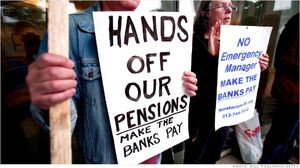Ponerized Detroit labor unions have betrayed the work force
In their closing arguments before the federal bankruptcy judge, Steven Rhodes, on Monday, the representatives of the city and the state gloated that they had so quickly wrapped up the largest municipal bankruptcy in US history. The "radical" restructuring plan, said Jones Day attorney Bruce Bennett, had not been "watered down." Indeed, the final proposal includes savage attacks on the working class - including pension cuts in violation of the state constitution and the virtual elimination of retiree health benefits.
Michigan's special attorney general, Steven Howell, told the court the "Chapter 9 filing had not been popular." Nevertheless, the initial objectors "were now supporters," he said, singling out the unions as examples of the "new spirit of cooperation" in Detroit.
Howell was acknowledging that the unions have played a critical role in the conspiracy to rob workers of basic social rights - a conspiracy involving the Democratic mayor and City Council, the Republican governor, the Obama administration, Judge Rhodes and Emergency Manager Kevyn Orr. The "spirit of cooperation" is directed against the widespread anger of workers throughout the Detroit area over the measures that are being implemented on behalf of the banks and large bondholders.
Throughout the bankruptcy, the unions have acted not as defenders of the workers, but as creditors with some of the biggest claims on the city's assets. The token opposition that the unions presented early on was aimed at securing a better deal for the wealthy executives who run them.
In the end, the unions declared their support for the "restructuring," i.e., plundering, of the city in exchange for control of a half-billion dollar health care investment fund, known as a VEBA. In his closing statements, Claude Montgomery, the attorney for the union-affiliated retiree committee, praised the "strategic decision" of Rhodes to bring the unions onboard in a so-called "grand bargain."
The retiree committee was advised by Ron Bloom. A senior vice president at the Wall Street investment firm Lazard, Bloom previously worked for the United Steelworkers union, helping protect the interests of the union officials as they collaborated with Wall Street asset strippers to destroy the jobs and pensions of hundreds of thousands of workers during the downsizing of the steel industry.
He later served as President Obama's point man with the United Auto Workers union during the forced bankruptcy of General Motors and Chrysler in 2009. In exchange for billions of dollars in corporate shares to fund its VEBAs, the UAW agreed to halve the wages of new workers, impose twelve-hour shifts, and enforce other cost reductions that have led to record profits for the Detroit auto makers.
The Obama administration has fully supported the Detroit bankruptcy, which it sees as a model for destroying the pensions and health benefits of millions of teachers, firefighters and other state and municipal workers across the country.
There is no limit to the greed and corruption of the individuals who run the unions. But the role of the unions in the Detroit bankruptcy reflects more than the repulsive subjective traits of the union leaders. It is rooted in the basic class character of these organizations.
Contrary to the claims of the various fake-left organizations that operate within and on the periphery of the unions, these are not working class organizations. They cannot be "reformed" and made to serve the workers' interests. They are instruments of the state and the ruling class, dedicated to blocking any struggle by workers against the dictates of the corporations and banks.
The antagonistic relationship of the unions to the working class is bound up with their political alliance with the Democratic Party and their commitment to the defense of the capitalist system.
The mass industrial unions in the United States, including the UAW, were established through bitter struggles of workers in defense of their basic rights. Detroit was a center of these struggles in the 1930s, the home of semi-insurrectionary class battles that took on the character of a civil war against the corporations. However, the trade union movement was led by a conservative bureaucracy that worked to channel mass opposition behind the Democratic Party and subordinate the working class to the profit system.
With the globalization of production, which gave transnational corporations the ability to shift production to low-wage regions of the world, the rug was pulled from underneath these nationally-based organizations. In every country, the unions responded by abandoning any resistance to factory closings, mass layoffs and wage-cutting in the name of making their "own" capitalists more competitive.
It has been more than 30 years since the American unions called a major national strike. They have imposed one disastrous concessions contract on the workers after another.
While the transformation of the unions at first proceeded most rapidly in the US, the process has been the same in every country. Earlier this month, officials of the German IG Metall union who sit on Volkswagen's executive board delivered a 400-page report outlining how the company could slash jobs and labor costs and triple its profits by the end of 2017.
On a world scale, the ruling classes are engaged in a social counterrevolution aimed at turning the clock back more than a century and destroying every gain won by the working class. Detroit has been singled out in part because of the historic role of the city's auto workers in the mass industrial struggles of the 1930s.
But today the unions are lined up with the bosses and the government against the workers. To fight back, workers must build new organizations of struggle that are democratically controlled by the rank-and-file.
At the same time, the Detroit bankruptcy has shown the necessity for workers to break with the Democrats and take up an independent struggle against the existing political system and the capitalist economic system it defends.



0 reacties:
Post a Comment